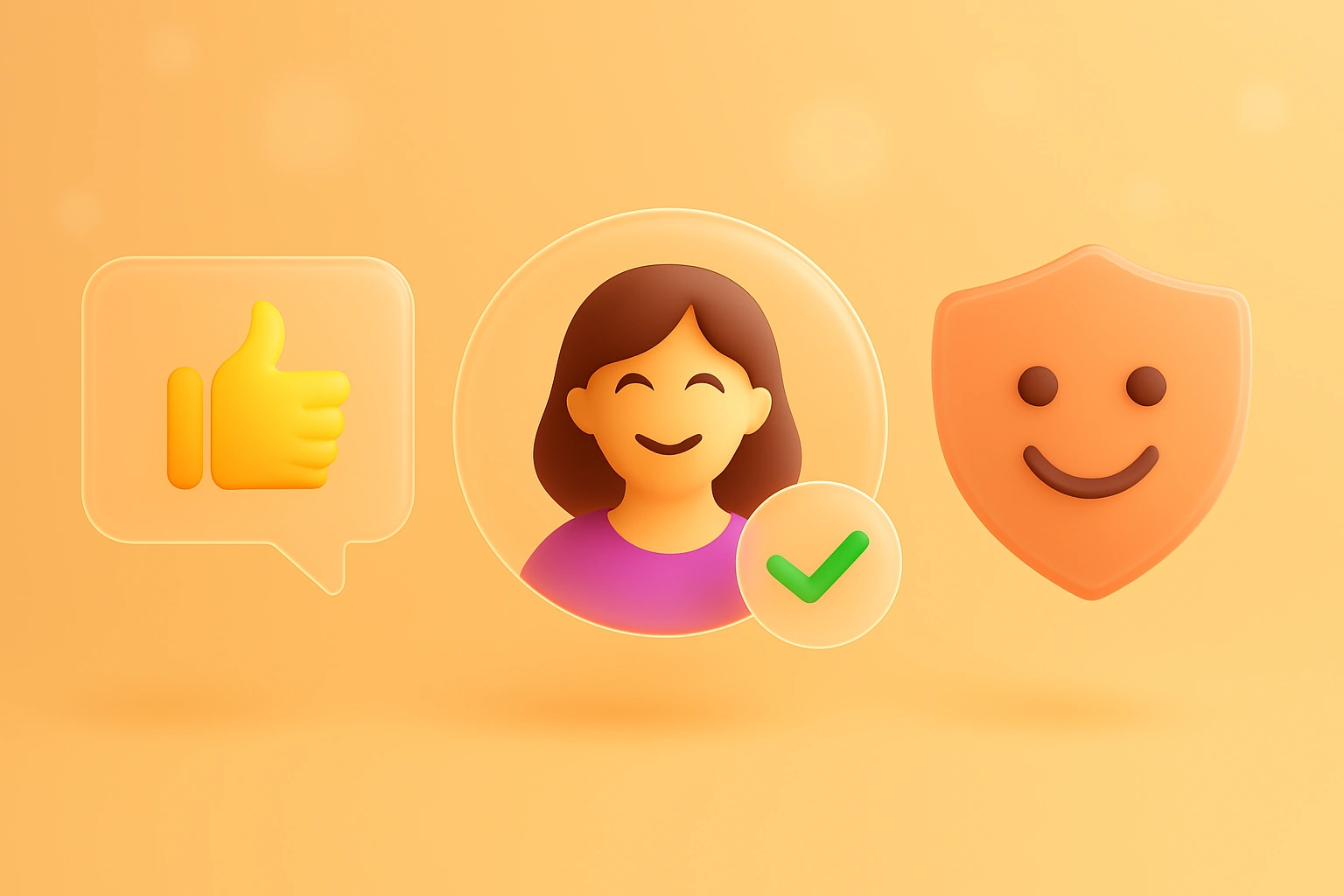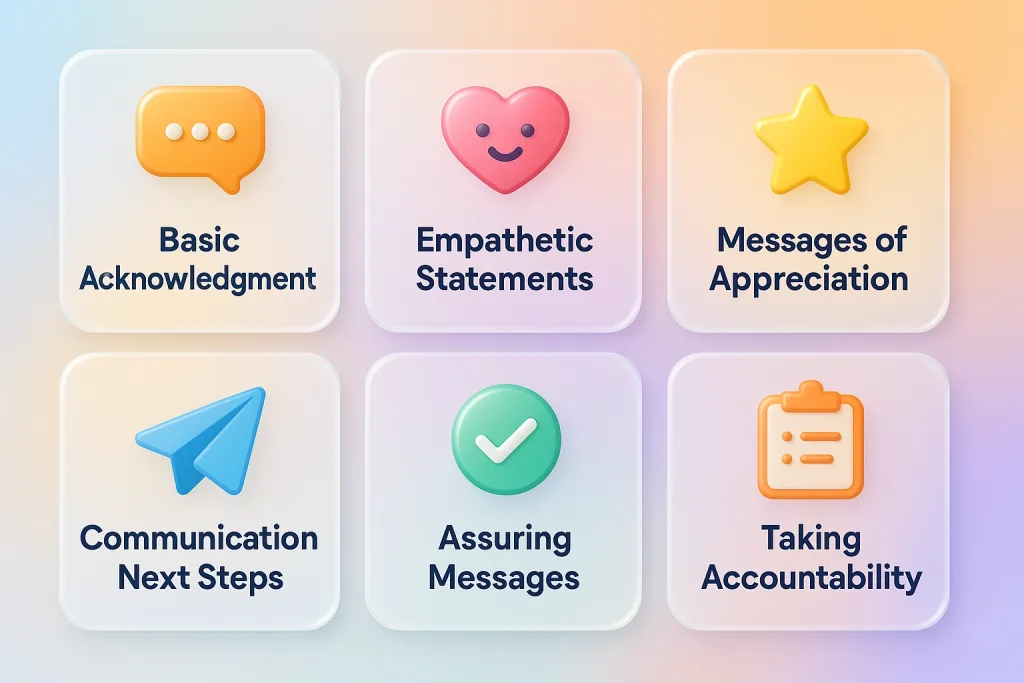15 Acknowledgment Statements for Customer Service in 2025
- July 15, 2025
- 18 mins read
- Listen

A customer reaches out after being double-charged. They wait in a queue, finally connect with support, and get this response: “Please provide your order number.” No empathy. No acknowledgment. Just a cold, transactional message.
Even if the issue is resolved, the damage is done. The customer feels ignored, and that emotional disconnect can leave a lasting negative impression.
Now flip the script. A simple statement like “I understand how frustrating that must be” can shift the entire tone of the conversation. It shows you care, not just about the issue, but also about the person.
That’s the power of acknowledgment in customer service. In this blog, we’ll explore how using the right words at the right time can turn difficult moments into trust-building opportunities.
What is Acknowledgment in Customer Service?
It is the act of a representative in a business acknowledging that he has received the complaint and will be dealing with it within a certain amount of time.
Acknowledgment is usually delivered via email, but not always. It can occur via fax, text, live chat, or over the phone, but it is always important that the customer knows that you have received his/her information and will be taking care of the issue.
Besides, customer service acknowledgment is an important part of customer service and is the first step in resolving many issues.
Importance of Acknowledgement in Customer Service
We are all in constant contact with companies, large and small, trying to get our needs fulfilled. There are times when the service we receive is just right, and then there are times when we’re left wondering what happened.
In today’s busy world, it seems that too many companies are forgetting the most important aspect of their businesses, the customer. The customer service representative is the face of the company, and their tone and demeanor can make or break a relationship.
Acknowledgment plays a vital role in customer service. It reassures customers that their concerns are heard and valued. A simple, genuine acknowledgment can make customers feel important and respected, often turning a negative experience into a positive, trust-building interaction.
Acknowledgment can sometimes be small things like saying the customer’s name, thanking the customer, or even apologizing for a mistake that was made by an employee. Whatever it is, it is always important to acknowledge a customer.
Types of Acknowledging Statements for Customer Service

Not all acknowledgment statements are the same. Each of them serves a unique purpose depending on the situation and customer emotion. From empathetic responses to appreciation-driven phrases, understanding the different types of acknowledgment statements helps your customer service agents respond with clarity, empathy, and professionalism. Let’s explore the key types in this section.
Basic Acknowledgment
You can use it to confirm to the customer that you have received and understood the message. For example, “Thanks for sharing that.”
Empathetic Acknowledgment
Such kind of statements show understanding and emotional validation of the customers’ feelings. For example, “I can understand how upsetting that must be.”
Paraphrasing Statements
Such statements restate the message to show that you have understood the problem clearly. For example, “Just to confirm, you’re asking for a refund due to the delay?”
Messages of Appreciation
Such statements express gratitude to the customers, highlighting that their time, effort, or cooperation is recognized and valued. For example, “Thank you for working with me to get this resolved.”
Communicating Next Steps
Such statements provide the customers with a clear idea of the upcoming actions taken and timelines, ensuring they know what to expect. For example, “I’ll check our current inventory and follow up with you shortly with an update.”
Assuring Messages
Such statements provide the customers with confidence that their concerns are being handled properly and will lead to a satisfactory outcome. For example: “Don’t worry, we’ll make sure this gets resolved to your satisfaction.”
Taking Accountability
Such statements acknowledge the issues and express genuine regret. For example: “I’m really sorry this happened!
15 Examples of Acknowledgement Statements in Customer Service
The goal of customer service acknowledgment is to make sure that the customer knows that their issue has been addressed and to provide the customer with a sense of closure.
The outcome of this process can be measured by how well the customer feels they have been served, how likely they are to recommend the company, and if they will continue to use the company in the future.
Let’s take a look at 15 examples of acknowledgment in customer service.
1. “I Realize That This Situation is Difficult, but Let’s Try and Find a Solution.”
In customer service, we are often trained to settle a customer complaint quickly and efficiently. Acknowledging their dissatisfactions, validating their right to feel that way, and stating that you understand their issues and are taking steps to correct them are some of the steps that are followed. Great! That is all good stuff!
However, in the heat of the moment, when a customer is being unreasonable, how do you respond? How do you deal with the irate customer?
In a case where you need to explain the facts of a situation that is not going their way, without allowing them to become defensive, it is important to choose your words carefully.
Since this can be a difficult situation for a customer service rep to handle, it is important to practice using phrases such as “I realize that this situation is difficult, but let’s try and find a solution” to help avoid an argument.
2. “I Would Feel the Same in Your Situation, but We Will Sort This Out…”
This is one of the most common phrases in customer service. It can be used to solve any problem or misunderstanding.
When you feel that the other party is not aware of their mistakes, it is easy to start the conversation with this phrase. You just need to say: ‘I would feel the same in your situation, but we will sort this out…’ when they are wrong.
It is one of the most effective phrases in any type of communication because everybody knows that everybody makes mistakes, and it is a great way to start a conversation.
There are two situations when you can use this phrase:
- When somebody asks you to do something and you don’t want to do it because you think he is wrong
- When somebody tells you that he is wrong and he wants to change the situation
In this situation, you will be able to fix the problem right away.
3. “That Sounds Frustrating, Let’s See What We Can Do.”

When your customer is upset or angry about something that you have done, this phrase is for him to understand that you feel the same as he does, but you will sort it out and fix the problem. The first thing to do is to pause and listen to what the customer says before responding, and if you can accept the feelings your customers have.
“That sounds frustrating, let’s see what we can do” is used to acknowledge a situation where a customer is dissatisfied and to attempt to resolve it in the best way possible.
An example where you can use such a statement is when customers complain about the long lines during the Christmas season.
4. “I Cannot Imagine How Upsetting It is to…”
It is a customer service phrase that demonstrates empathy and asks the customer to help with your understanding.
Emotional reasoning is when you assume that your emotional reaction should be shared by other people. So, when a customer tells you they are upset, they are assuming your reaction will be the same as theirs.
Knowing this secret allows us to do two things:
- First, we can change the moment by restoring calmness and composure.
- Second, we can talk about how we can solve the problem (which is what our customers want to hear).
5. “I’m Sorry to Hear That. Let Me See What I Can Do to Help You.”
Many of us have used the phrase “I’m sorry to hear that” when a customer is speaking to us in call center roles. We may think it’s just a courtesy phrase, but it does more than that. It shows we truly care about them and their issues.
The phrase “I’m sorry to hear that” first came to my attention when I was working at my previous company as a customer care agent. I would get calls from customers who were upset over something that couldn’t get fixed or just wanted to vent.
I started saying, “I’m sorry to hear that”, and they would tell me everything. Then I would say, “Let me see what I can do to help you,” and they would tell me everything again.
It created a moment of trust and made me resolve their issues in a better way.
6. “I’d Be Delighted to Help You.”
In customer service, the goal is always to make things right for the customer. However, there are times when you need to acknowledge that a perfect resolution may not be possible. But it’s still important to show that you are committed to finding the best possible solution for your customers.
The phrase “I’d be delighted to help you” can be a great way to express this. It acknowledges your willingness to assist, even if the exact outcome the customer wants can’t be delivered.
You can use “I’d be delighted to help you” in a variety of situations—from answering general product inquiries to addressing more complex problems or complaints.
7. “Don’t Worry, You Have the Best Person on the Phone to Assist You.”
The phrase “Don’t worry, you have the best person on the phone to assist you” is a powerful acknowledgment statement, especially when dealing with an angry or frustrated customer.
In such situations, many businesses tend to rely on generic or ineffective responses to defuse tension. However, using this phrase can help calm the customers because it reassures them that they are speaking with someone who genuinely cares and is fully capable of helping them.
8. “You Are Absolutely Correct.”
“You are absolutely correct” is one of the most challenging statements to use in customer service. It is a statement of high praise, typically reserved for those exceptional agents who win over a customer through outstanding service.
It’s also a powerful reinforcement phrase that helps agents stay confident and focused when they are clearly in the right, especially if they anticipate pushback or aggressive behavior from the customer.
When agents are right, they might sense the customer thinking—or even hear them say—“What do you mean I’m correct? I want you to admit your fault. You are obviously wrong.” Instead of responding with a “Umm…” or an “Oh…” or taking a completely defensive stance, agents who use “You are absolutely correct” take control of the conversation. It resolves the tension and shows the customer that the agent is confident and composed.
9. “If I Am Understanding Correctly…”
If I am understanding correctly… is a phrase that can be used to acknowledge and clarify something that the other person just said.
It is a phrase that you can use when you are not sure what the other person said because they may have been talking too fast, might have pronounced something with an accent that you could not get, or could be speaking a language that you do not know properly.
10. “You’re Right”
“You’re right” is one of the many magic words that can be used during customer service to make your customers happy.
This is a powerful statement that works like magic in customer service to diffuse and de-escalate a situation when the issue at hand is caused by an employee.
The main goal is to give back the power to the customer and to acknowledge their point of view on the matter. “You’re right” can be used as a way to share ownership of the mistake with the customer, and this will allow you to address issues quickly and move forward.
It is important as well to use “you’re right” in a timely manner, as it could help you avoid an escalation. You are acknowledging what your customer is saying and that you agree with him, and then move forward.
11. “Thank You for Reaching Out to Us About This.”
Use the “thank you for reaching out to us about this” acknowledgment statement in customer service when you want to tell customers that you are working on their requests, and/or thank them for reaching out to you about their issues.
For example, the “thank you for reaching out to us about this” is commonly used in the banking and credit card industries when dealing with fraudulent transactions and claims. This statement is also used in retail stores, restaurants, and even by contractors.
12. “I Am So Sorry to Hear That You Are Going Through This.”

This is what you want to say when a customer shares that he is experiencing something difficult, such as a loss, an injury, an illness, or a natural disaster. The goal is to show empathy and support, rather than sounding cold or impersonal with a generic line like “We apologize for any inconvenience this has caused you.”
The language used during a difficult time is important and can significantly impact the customer’s emotional state.
So, use the phrase “I am so sorry to hear that you are going through this” when someone tells you he has lost his job, his pet has passed away, etc, and offer them assistance through your company’s programs or direct support resources.
13. “I Truly Understand How Difficult and Challenging That Can Be for You.”
There are many ways in which a customer experience can be enhanced. However, when it comes to showing genuine empathy, there is nothing better than saying, “I truly understand how difficult and challenging that can be for you”.
These words give the customer a sense of your understanding. Let’s face it, sometimes we do have really bad experiences with some brands.
For example, the remote doesn’t work, the product is damaged, etc, and when things like that happen, we want two things: we want to be heard and we want to be helped.
But far too often, we don’t get what we want. There are several reasons why this happens – because of the language barrier, because of a misunderstanding, because of a lack of empathy, or simply because the product was indeed defective and the customer was angry – and in this case, that’s OK.
But what isn’t OK is the fact that there isn’t even an attempt to show empathy. In some cases, there is a sense that you are being dismissed or are being treated like a “nuisance”.
14. “I Appreciate Your Patience.”
This is a particularly useful strategy when you are handling customer complaints. It’s a way of saying “thank you for being patient with me” without apologizing directly. It also sends a subtle message to the customers that you don’t take their frustration personally.
To be successful, use this expression with an authentic tone. This statement will positively impact your company’s reputation.
15. “Thank You for Remaining So Positive.”

This can be another way of saying “thank you for your patience” or “we appreciate your understanding,” but adding “positive” at the end helps prevent the customer from becoming defensive.
This phrase can be used in a variety of customer service situations, such as?
- A customer receives his order, is extremely happy, loves everything, and is just thrilled with his purchase
- A customer is reporting an issue, but his tone reflects gratitude and shows he appreciates your effort to resolve it
- A customer is very angry, even raising his voice, but suddenly says he will wait to speak with a supervisor or call back later.
Customer Service Acknowledgement: Key Components You Need to Know
A great customer service acknowledgement goes beyond a generic “We’ve received your request” type of response. It should include some key components that reassure the customer, set clear expectations, and demonstrate empathy. Next, let’s explore what makes an effective acknowledgement message and the essential elements you should include.
- Use a Personal Tone to Build Immediate Trust
When acknowledging a customer, using a personal tone makes a big difference, especially when you choose “I” instead of “we.” While “we” can sound distant or overly formal, “I” makes the response feel more one-on-one.
This simple shift helps the customer feel like there’s a real person, not just a faceless company, on the other side. Also, calling the customer by his/her name is a great way to make the conversation more personal.
For example, instead of saying:
“We have received your message and will get back to you shortly.”
Try saying:
“Hi Sarah, I’ve received your message and I’m looking into this for you now.”
- Clearly State the Next Step
Acknowledging a customer’s concern is a good start, but you have to pair it with a clear indication of what happens next.
When you include a specific action or timeline, it sends the message that the issue is being taken seriously and necessary steps to resolve it have already been taken.
For example, instead of saying:
“Thanks for letting us know. We’ll look into it.”
Try:
“Thanks for informing me, Mark. I’ve reported the issue to our tech team, and they’re already investigating it. I’ll update you within the next 2 hours.”
- Acknowledge the “No,” Then Focus on the “Can”
While avoiding negative words might seem polite, it can actually lead to various confusions. Customers appreciate honesty, as long as it’s paired with a helpful solution.
Rather than directly saying a “no,” it’s more effective to be upfront about what isn’t possible. Then, immediately, you can offer a solution to make things better.
For example, instead of saying:
“At this time, we are unable to process your refund. However, we are happy to offer store credit as a gesture of goodwill.”
Try:
“I’m really sorry, we can’t offer a refund on this item, but I can issue you store credit right away so you don’t lose value.”
- End on a Collaborative Note
Starting your acknowledgement with “I” makes the response personal, but ending it with “we” reinforces a sense of partnership. It tells the customer: “You’re not alone in this—we’re in it together.”
By using “we” to mean the agent and the customer (not just the company), you shift from the concept of service provider vs. customer to a team working toward the same goal. This shift strengthens the bond and gives the customers confidence that they have someone on their side.
For example, instead of ending with:
“I’ll let you know once your issue gets resolved.”
Try:
“Let’s keep in touch while we sort this out together. I’ll update you as soon as I get an update from the team.”
- Speak Like a Human, Not a Script
Customers can spot a scripted response from miles away, and nothing kills trust faster than a robotic reply during a sensitive moment. So, authenticity is key in making acknowledgement statements feel personal and respectful.
When agents speak in a natural, conversational tone, they sound more relatable and empathetic. Instead of leaning on generic phrases like “I understand how you feel,” it’s more effective to respond with empathy that feels truly personal.
For example. instead of saying:
“I understand how you are feeling right now. We apologize for the delay.”
Try:
“That delay must be incredibly frustrating. I’m really sorry, and I’ll do everything I can to speed things up.”
Wrapping Up!
Acknowledging a customer service issue is an important step that benefits both the customer and the business. For the customers, it builds trust and shows they are truly valued. For the company, it’s an opportunity to demonstrate importance and commitment, key ingredients for long-term loyalty.
However, the effectiveness of an acknowledgement depends entirely on how it’s delivered. Authenticity, clarity, and empathy in your statements make all the difference.
If you are looking to deliver timely, personalized assistance to your customers, REVE Chat can help. It’s an AI-powered customer service platform that allows you to instantly assist them via your website, mobile apps, and social media platforms. With REVE Chat, you can tailor every interaction to make customers feel heard, respected, and supported.
Want to experience the difference? Sign up for a 14-day free trial and explore all of REVE Chat’s powerful features firsthand.
Frequently Asked Questions
Acknowledgment statements in customer service are phrases used by representatives to validate a customer’s feelings, concerns, or issues. These statements show empathy and understanding, helping to create a connection and demonstrating that the customer is being heard. Examples include “I understand how frustrating this must be” or “Thank you for sharing this with us.
Customer acknowledgment refers to the act of recognizing and validating a customer’s issue, feedback, or request. It involves actively listening to the customer and responding in a way that shows their concerns are taken seriously, which can help in resolving issues and improving customer satisfaction.
To acknowledge customer service, representatives should actively listen to the customer, empathize with their situation, and provide reassuring responses. Use phrases like, “I see what you mean,” or “I understand how this can be upsetting,” to show the customer that their concern is being addressed.
Examples of acknowledgment phrases in customer service include:
- “I completely understand how you feel.”
- “Thank you for bringing this to our attention.”
- “I’m sorry you’re experiencing this. Let’s fix it right away.”
- “I appreciate your patience while we resolve this.” These phrases help in acknowledging the customer’s experience and moving the conversation toward resolution.
Positive statements for customer service focus on empathy, assurance, and a commitment to solving the customer’s problem. Examples include:
- “I’m happy to help you with that!”
- “We will do everything we can to resolve this issue.”
- “Thank you for giving us the opportunity to assist you.” These statements foster a positive and supportive environment during customer interactions.
When writing an acknowledgment, begin by expressing understanding or empathy for the customer’s concern. Provide reassurance and explain the next steps. For example, “Thank you for reaching out. I understand how important this issue is, and we’re working on resolving it as quickly as possible.”
To acknowledge a customer complaint, express empathy and take responsibility. Acknowledge the customer’s frustration and reassure them that the issue will be resolved. For example, “I’m really sorry you had this experience. I completely understand why you’re upset, and we will address this immediately.”
Acknowledgment statements are essential because they help customers feel heard and valued. They create a positive interaction, reduce frustration, and pave the way for effective problem resolution. Acknowledging a customer’s concern leads to greater satisfaction and can foster loyalty.
Acknowledgment statements contribute to effective customer service by building rapport and trust between the customer and the representative. They show empathy, make customers feel understood, and set the tone for resolving the issue. This enhances the overall customer experience and increases the likelihood of a positive outcome.
Customer service representatives can improve their use of acknowledgment statements by:
- Actively listening to customers without interrupting.
- Using empathetic language that reflects the customer’s feelings.
- Personalizing responses based on the specific issue the customer is facing.
- Maintaining a positive tone and focusing on solutions. Improving these skills can lead to more successful interactions and higher customer satisfaction.




